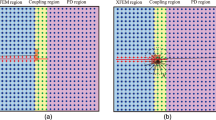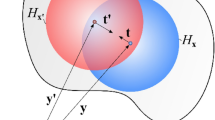Abstract
A new dynamic particle difference method (PDM) for the simulation of a proportionally damped system subjected to dynamic load and the fracture simulation of cracked concrete beam is presented. The dynamic PDM utilizes only node model without involving any mesh or grid structure to take advantage of the merits of strong formulation; it remarkably accelerates computational speed owing to the avoidance of numerical integration and also sophisticatedly handles awkward topological change due to the crack growth in node model. The proportional damping is successfully implemented in the dynamic PDM by adding both mass and stiffness proportional terms to the equation of motion and the constitutive equation, respectively. It provides extra stability in the dynamic fracture simulation by eliminating erroneous oscillations. Governing partial differential equation is straightforwardly discretized in time by using the central difference method. However, a novel modification is devised in the Newmark method implementation where the transient equations and update formulae for kinematic variables are newly formulated; this modification appropriately corrects the period and amplitude of kinematic variable responses. The stability and accuracy of the developed methods are verified by solving various dynamic problems involving transient loading. Furthermore, the fracture process of the cracked concrete beam under the impact loading is successfully simulated and the dynamic energy release rates are effectively evaluated during the simulation.


























Similar content being viewed by others
References
Aluru NR (2000) A point collocation method based on reproducing kernel approximations. Int J Numer Meth Eng 47:1083–1121
Assimaki D, Kausel E (2002) An equivalent linear algorithm with frequency- and pressure-dependent moduli and damping for the seismic analysis of deep sites. Soil Dyn Earthq Eng 22(9–12):731–1214
Belytschko T, Hughes TJR (1983) Computational methods for transient analysis. Volume 1 in computational methods in mechanics. Elsevier Science Publish, New York
Belytschko T, Lu YY, Gu L (1994) Element-free galerkin methods. Int J Numer Meth Eng 37:229–256
Belytschko T, Tabbara M (1996) Dynamic fracture using element-free galerkin methods. Int J Numer Meth Eng 39:923–938
Belytschko T, Black T (1999) Elastic crack growth in finite elements with minimal remeshing. Int J Numer Meth Eng 45:601–620
Belytschko T, Organ D, Gerlach C (2000) Element-free galerkin methods for dynamic fracture in concrete. Comput Methods Appl Mech Eng 187:385–399
Bessa MA, Foster JT, Belytschko T, Liu WK (2014) A meshfree unification: reproducing kernel peridynamics. Comput Mech 53:1251–1264
Chen J-S, Wu C-T, Yoon S, You Y (2001) A stabilized conforming nodal integration for Galerkin mesh-free methods. Int J Numer Meth Eng 50:435–466
Chen J-S, Han W, You Y, Meng X (2003) A reproducing kernel method with nodal interpolation property. Int J Numer Meth Eng 56:935–960
Clough RW, Penzien J (1975) Dynamics of structures. McGraw-Hill, New York
Dominguez J (1993) Boundary elements in dynamics. Computational Mechanics Publications
Duarte CA, Babuška I, Oden JT (2000) Generalized finite element methods for three dimensional structural mechanics problems. Comput Struct 77:215–232
Duarte CA, Hamzeh ON, Liszka TJ, Tworzydlo WW (2001) A generalized \(\textregistered \)nite element method for the simulation of three-dimensional dynamic crack propagation. Comput Methods Appl Mech Eng 190:2227–2262
Fernandez-Mendez S, Huerta A (2004) Imposing essential boundary conditions in mesh-free methods. Comput Methods Appl Mech Eng 148:257–277
Fleming M, Chu YA, Moran B, Belytschko T (1997) Enriched element-free galerkin methods for crack tip fields. Int J Numer Meth Eng 40:1483–1504
Freund LB (1990) Dynamic fracture mechanics. Cambridge University Press, Cambridge
Gosz J, Liu WK (1996) Admissible approximations for essential boundary conditions in the reproducing kernel particle method. Comput Mech 19:120–135
Gu YT, Liu GR (2005) A meshfree weak-strong (MWS) form method for time dependent problems. Comput Mech 35:134–145
Hughes T (1987) The finite element method: linear static and dynamic finite element analysis. Prentice-Hall Inc, Upper Saddle River
Jehel P, Leger P, Ibrahimbegovic A (2014) Initial versus tangent stiffness-based Rayleigh damping in inelastic time history seismic analyses. Earthq Eng Struct Dyn 43(3):467–484
John R, Shah SP (1990) Mixed mode fracture of concrete subjected to impact loading. ASCE J Struct Eng 166:585–602
Krongauz Y, Belytschko T (1996) Enforcement of essential boundary conditions in meshless approximations using finite elements. Comput Methods Appl Mech Eng 131:133–145
Krysl P, Belytschko T (1997) Element-free galerkin method: convergence of the continuous and discontinuous shape functions. Comput Methods Appl Mech Eng 148:257–277
Kim DW, Kim YS (2003) Point collocation method using the fast moving least-square reproducing kernel approximation. Int J Numer Meth Eng 56:1445–1464
Kim DW, Kim H-K (2004) Point collocation method based on the FMLSRK approximation for electromagnetic field analysis. IEEE Trans Magn 40(2):1029–1032
Kim DW, Yoon Y-C, Liu WK, Belytschko T (2007a) Extrinsic meshfree approximation using asymptotic expansion for interfacial discontinuity of derivative. J Comput Physcs 221:370–394
Kim DW, Liu WK, Yoon Y-C, Belytschko T, Lee S-H (2007b) Meshfree point collocation method with intrinsic enrichment for interface problems. Comput Mech 40(6):1037–1052
Krysl P, Belytschko T (1999) The element free galerkin method for dynamic propagation of arbitrary 3-d cracks. Int J Numer Meth Eng 44:767–800
Lee S-H, Yoon Y-C (2004) Meshfree point collocation method for elasticity and crack problems. Int J Numer Meth Eng 61(1):22–48
Lee S-H, Kim K-H, Yoon Y-C (2016) Particle difference method for dynamic crack propagation. Int J Impact Eng 87:132–145
Lin W-H, Chopra AK (2002) Earthquake response of elastic SDF systems with non-linear fluid viscous dampers. Earthq Eng Struct Dyn 31(9):1623–1642
Liu WK, Jun S, Zhang Y (1995) Reproducing kernel particle methods. Comput Methods Appl Mech Eng 191:1421–1438
Liu WK, Kim DW, Tang S (2007) Mathematical foundations of the immersed finite element method. Comput Mech 39:211–222
Long SY, Liu KY, Hu DA (2006) A new meshless method based on MLPG for elastic dynamic problems. Eng Anal Boundary Elem 30:43–48
Lu YY, Belytschko T, Tabbara M (1995) Element-free Galerkin method for wave propagation and dynamic fracture. Comput Methods Appl Mech Eng 126:131–153
Luo Y, Häussler-Combe U (2002) A generalized finite-difference method based on minimizing global residual. Comput Methods Appl Mech Eng 191:1421–1438
Menouillard T, Belytschko T (2010) Smoothed nodal forces for improved dynamic crack propagation modeling in XFEM. Int J Numer Meth Eng 84:47–72
Moës N, Dolbow J, Belytschko T (1999) A finite element method for crack growth without remeshing. Int J Numer Meth Eng 46:131–150
Oñate E, Idelsohn S, Zienkiewicz OC, Taylor RL, Sacco C (1996) A stabilized finite point method of analysis of fluid mechanics problems. Comput Methods Appl Mech Eng 139:315–346
Rabczuk T, Bordas S, Zi G (2010) On three-dimensional modelling of crack growth using partition of unity methods. Comput Struct 88:1391–1411
Rethore J, Gravouil A, Combescure A (2005) An energy-conserving scheme for dynamic crack growth using the eXtended finite element method. Int J Numer Meth Eng 63:631–659
Sadeghirad A, Iradj MK, Mohammad R, Ali VA (2009) A numerical approach based on the meshless collocation method in elastodynamics. Acta Mech Sin 25:857–870
Sladek J, Sladek V, Mang HA (2003) Meshless LBIE formulations for simply supported and clamped plates under dynamic load. Comput Struct 81:1643–1651
Song JH, Wang H, Belytschko T (2008) A comparative study on finite element methods for dynamic fracture. Comput Mech 42:239–250
Yoon Y-C, Lee S-H, Belytschko T (2006) Enriched meshfree collocation method with diffuse derivatives for elastic fracture. Comput Math Appl 51(8):1349–1366
Yoon Y-C, Song J-H (2014a) Extended particle difference method for weak and strong discontinuity problems: part1. Derivation of the extended particle derivative approximation for the representation of weak and strong discontinuities. Comput Mech 53(6):1087–1103
Yoon Y-C, Song J-H (2014b) Extended particle difference method for weak and strong discontinuity problems: part2. Formulations and applications for various interfacial singularity problems. Comput Mech 53(6):1105–1128
Yoon Y-C, Song J-H (2014c) Extended particle difference method for moving boundary problems. Comput Mech 54(3):723–743
Zhu, Atluri (1998) A modified collocation method and a penalty formulation for enforcing the essential boundary conditions in the element free Galerkin method. Comput Mech 21:211–222
Zhang X, Liu X-H, Song K-Z, Lu M-W (2001) Least-squares collocation meshless method. Int J Numer Meth Eng 51:1089–1100
Zi G, Rabczuk T, Wall W (2007) Extended meshfree methods without branch enrichment for cohesive cracks. Comput Mech 40:367–382
Acknowledgments
This research was supported by Basic Science Research Program through the National Research Foundation of Korea (NRF) funded by the Ministry of Science, ICT & Future Planning (2014R1A1A1002000).
Author information
Authors and Affiliations
Corresponding author
Rights and permissions
About this article
Cite this article
Yoon, YC., Kim, KH. & Lee, SH. Dynamic particle difference method for the analysis of proportionally damped system and cracked concrete beam. Int J Fract 203, 237–262 (2017). https://doi.org/10.1007/s10704-016-0150-6
Received:
Accepted:
Published:
Issue Date:
DOI: https://doi.org/10.1007/s10704-016-0150-6




